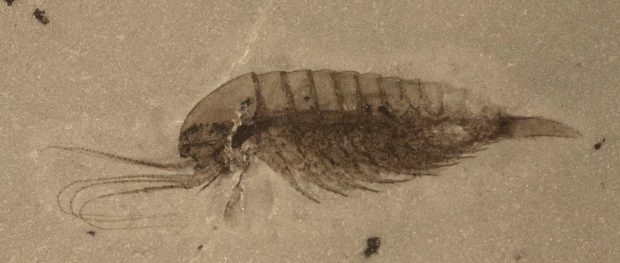
Leanchoiliid fossil from the Qingjiang biota —Photo by X. Zhang
Geology: Back to the Cambrian
These days, whenever there’s a truly earthshaking development in the world of Cambrian fossils, Professor of Geology Robert Gaines seems to find himself squarely in the middle of it. Last year, it was an article in Science called “Cracking the Cambrian,” about the latest discoveries in the fossil-rich sites that Gaines and his team unearthed in Canada’s Kootenay National Park back in 2012—considered one of the most important geological finds in recent history. This year, it’s something that may be even bigger: a 518-million-year-old fossil site unearthed in the Yangtze Gorges area of South China that may turn out to be even more important, according to a new article, also published in Science.
The new site—dubbed the Qingjiang biota—was discovered by a team of Chinese researchers in South China. It’s home to a nearly pristine and diverse 500-million-year-old fossil record that has not been impacted by metamorphosis or weathering. The diversity of its fossils may rival that of the Burgess Shale of British Columbia and the Chengjiang fossil site in China’s Yunnan province, which are considered two of the most important fossil finds of the 20th century, according to Gaines, the only American on the team that is studying the site. The new site is more than 600 miles from Chengjiang.
In addition to their high taxonomic diversity, Qingjiang fossils are characterized by near-pristine preservation of soft-bodied organisms—including juvenile or larval forms, arthropod and worm cuticles and jellyfishes—and soft-tissue features that are rarely seen in the fossil record. More than 4,000 specimens have already been collected, with 101 species identified. Of these species, 53 are so new to science that names have to yet to be assigned to them.
“This finding enriches our view of the early animal world and offers us really remarkable views of the simplest animals,” says Gaines. “One of the most incredible things about this finding is the pristine condition of many of these specimens—fossils that haven’t been substantially affected by impacts of time, and in them you can clearly see soft tissues like eyes, tentacles and gills.”
Biology: Olson Wins NSF Grant for Nematode Research
Pomona College Biology Professor Sara Olson has been awarded a prestigious Faculty Early Career Development Award from the National Science Foundation (NSF) to explore the process of embryo development in roundworms. The five-year award of $827,962 will fund her study, as well as research opportunities for Pomona College biology and molecular biology students and rising high school seniors in the Pomona College Academy for Youth Success (PAYS) program.
Using fluorescence microscopy, biochemistry, molecular biology and genetic approaches, Olson’s research focuses on the nematode worm C. elegans, a roundworm, as a model organism to explore how protective barriers form around embryos. Findings from this study could shed light on early embryonic development in other species, including mammals.
“The idea of building a protective barrier around an embryo is common throughout the animal kingdom,” says Olson. “From worms to flies to fish to mammals, all of these animals build protective barriers around their embryos. We study how that barrier forms over the egg during early development. Before fertilization, it has to be porous so the egg is accessible to the sperm, but after fertilization it has to get remodeled and be closed off for protection.”
Another goal is to identify new drug targets to fight parasitic roundworm infection in humans, plants and animals. “These parasitic worms affect people in developing countries in Africa, Central and South America and Southeast Asia,” says Olson. “Parasitic nematode infections are a major burden that cause loss in agriculture, sickness in humans and loss of productivity. If we can figure out how the worm’s eggshell is built, we can also figure out how to destroy it in the parasitic worms.”
